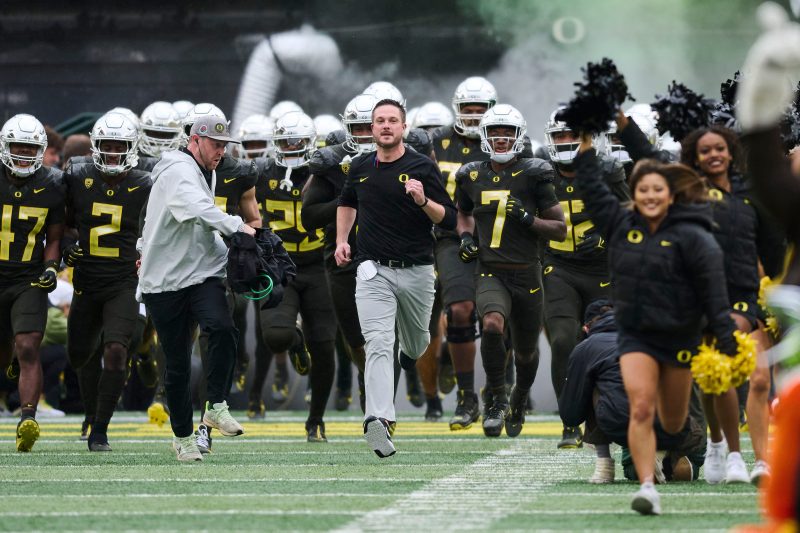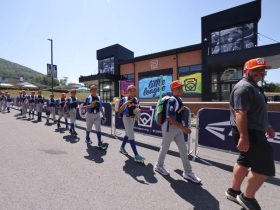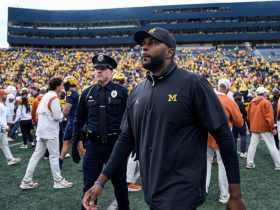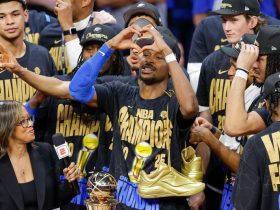LAS VEGAS — He’s selling it because he believes it. Or maybe there’s no alternative when you’re deep into the buildout.
Oregon is doubling down, Dan Lanning says. Just one bad game away for the program that spent more time than any other at No. 1 last season — then played its worst game since the last time they played the eventual national champion.
And lost by 46.
That was Lanning’s first game at Oregon in 2022, a brutal loss at the hands of Georgia that can only be eclipsed by the brutal loss at the hands of eventual national champion Ohio State in last year’s Rose Bowl College Football Playoff quarterfinal — as the nation’s No.1 team and national title favorite.
But ignore those bookend beatdowns, there’s a bigger picture here.
“The process works,” Lanning said on the dais at Big Ten Media Days, throwing talking points chum to the masses. “We’re close.”
This, of course, means next to nothing in the coaching world of ‘you’re the last thing you put on tape.’
So I got Lanning away from the stage Wednesday, and asked what exactly does doubling down mean? Oregon has won 35 games in his three seasons, and last year won the conference championship in its first season in the Big Ten.
The Ducks have hit nearly every significant metric of growth under Lanning, from elite recruiting, to a winning record vs. ranked teams, to sitting on top of the college football world for nearly two months.
MAN WITH PLAN: Oregon’s Lanning pitches playoff that ends Jan. 1
So what in the name of Dan Fouts does doubling down mean?
“We’ve had a lot of success, and I really attribute that to our growth mindset,” Lanning said. “Our DNA mindset of who we are.”
Wait, what?
So I got annoyed with the nothing answer, and Lanning got annoyed at me — and the next thing you know, Kirby Smart arrived. And by Kirby Smart, I mean the aura of the best coach in college football and Lanning’s mentor.
And it went about like what you’d think.
“Doubling down is continuing to work your ass off at practice,” Lanning said. “Doubling down is continuing to run when your body tells you ‘no.’ Doubling down is getting necessary sleep. It’s focusing intently on all those pieces and more. All the time.”
Hallelujah, now we’re getting somewhere.
There’s a reason Lanning and three Oregon players who attended Big Ten media days were peppered with questions about the loss to Ohio State, and the impact moving forward. And it’s not because of the hoard of swooning Ohio State media endlessly reliving Scarlet and Gray glory.
When you fail so spectacularly on the biggest stage of all, there must be a complete deconstruction of the disaster. It’s not simply losing to a better team, which Ohio State was on that day.
It’s how did it fall apart so quickly, and how was the preparation so ineffective? How was an Oregon team built for this moment so out of its element?
Ohio State scored on the third play of the game. Ohio State’s first two scoring drives took all of six plays.
Ohio State led by 31 midway through the second quarter, and Oregon looked a whole lot like the Ducks team that was dismantled in Lanning’s first game against Georgia. Outcoached, outplayed, outclassed.
So yeah, it’s a fair question to ask how that Rose Bowl loss translates to 2025, especially considering this talented Oregon team has gone from a record-setting quarterback (Dillon Gabriel) with 63 career starts, to one (Dante Moore) with five.
You don’t grind for three years on a buildout, painstakingly changing everything about a program and molding it into what Nick taught Kirby and Kirby taught you, and ignore the elephant in the room.
“A lot of work, man, a lot of it,” said Oregon linebacker Bryce Boettcher, a two-sport athlete who returned for his senior season instead of playing professional baseball.
He hasn’t forgotten the suddenness of what happened in Pasadena on New Year’s Day. Why in the world would he?
“It drives you,” Boettcher continued. “It’s hard to explain, the way it ended. That’s a problem. That’s not something you ever forget.”
And that’s where Lanning tangibly doubled down on what he knows works. He protected his roster from key transfer portal defections, and added a handful of critical pieces (starting OTs Isaiah World and Alex Harkey, RB Makhi Hughes) to solidify the team around Moore.
He went from taking a small group of players on a leadership retreat, to taking 35. Because more is better when adversity hits, and because good teams are led by coaches. Great teams are led by players.
Great teams that can withstand giving up a touchdown on the third play of the Rose Bowl, and not crawl into a fetal position at the thought of it all.
A great, player-led team goes on the road this year in the Big Ten, and isn’t impacted by a whiteout at Penn State, or a 3,000-mile trip to Piscataway, New Jersey. Because who among us wouldn’t travel three time zones to reach lovely Piscataway?
A great, player-led team isn’t concerned with anything but doubling down and completing the buildout.
“What happened last year has nothing to do with the future,” Lanning said.
Neither do the bookend beatdowns.
But they’re all part of the bigger picture.
Matt Hayes is the senior national college football writer for USA TODAY Sports Network. Follow him on X at @MattHayesCFB.









